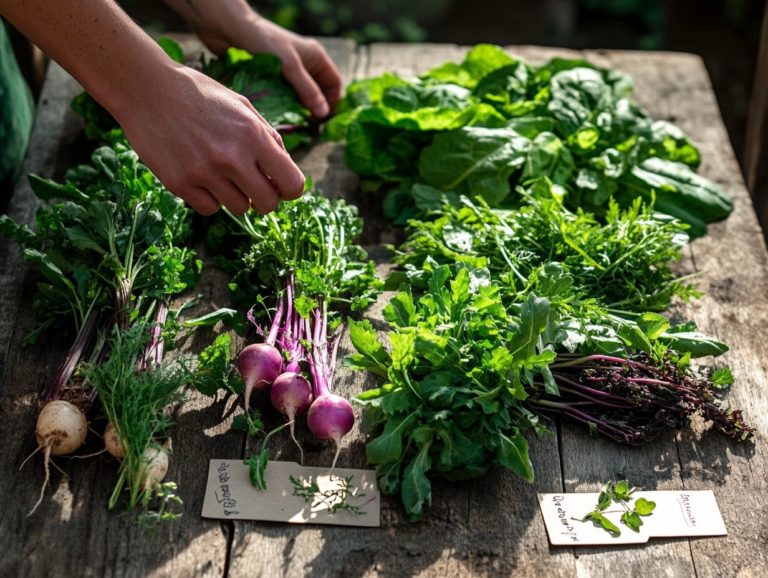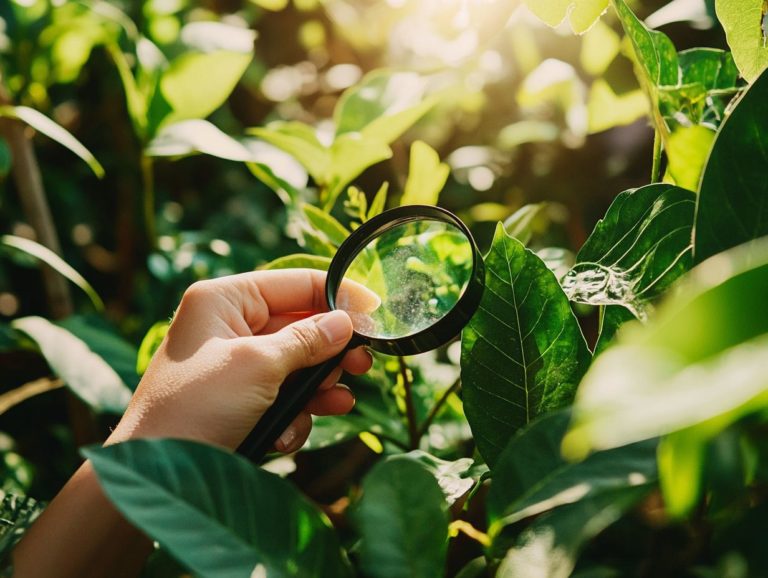How to Use Local Flora for Identification
Understanding local flora, including native plants, is essential for anyone who appreciates the beauty of nature. This includes casual hikers, aspiring botanists, and seasoned gardeners alike.
This article equips you with valuable insights for flora identification in your area. It provides tools and a step-by-step guide that will enhance your identification skills.
You ll learn about common pitfalls to avoid. Additionally, you’ll discover resources that can deepen your understanding of plant taxonomy.
Dive in and discover how recognizing native flora will elevate your outdoor experiences. It will also nurture a richer connection with the local environment.
Contents
- Key Takeaways:
- Tools for Identifying Local Flora
- Step-by-Step Guide to Identifying Local Flora
- Common Mistakes in Identifying Local Flora
- Additional Resources for Identifying Local Flora
- Frequently Asked Questions
- How can I use local flora for identification?
- What are some common characteristics to look for when identifying local flora?
- Can I use local flora for medicinal purposes?
- How accurate are plant identification apps?
- Why is it important to properly identify local flora?
- Are there any safety precautions I should take when using local flora for identification?
Key Takeaways:

The Importance of Knowing Local Flora
Understanding local flora is essential for your ecological education and habitat protection. It enhances your ecological knowledge and enables you to engage with your community.
By recognizing native plants like Mountain Laurel and Common Blue Violets, you can actively contribute to helping to protect local habitats and fostering a better understanding of the variety of life in your area.
This knowledge not only helps you identify plant families and their unique characteristics but also supports the overall health of ecosystems and wildlife.
Developing your identification skills deepens your appreciation of the local environment and encourages sustainable practices. This connection to local greenery offers a wealth of benefits, affecting everything from habitat conservation to community engagement.
For instance, knowing which plants are native can inspire you and your friends to start volunteer groups that initiate restoration projects, ultimately creating healthier ecosystems.
Excitingly, real-life examples show how crucial plants like Milkweed are! They support Monarch butterfly populations and highlight the vital role of local flora. Understanding how one species can ripple through the ecosystem illustrates the importance of local flora and its role in ecosystem support.
As you and your community recognize the significance of these native species, you simultaneously nurture a deeper appreciation for the interconnectedness of all life.
Tools for Identifying Local Flora
Equipping yourself with the right tools for plant identification is crucial for anyone eager to delve into and appreciate the local flora. From classic field guides that offer timeless wisdom to cutting-edge identification apps like iNaturalist, these tools will help you learn to spot native plants more easily.
Essential Tools for Accurate Identification
Accurate plant identification demands a blend of essential tools. These include comprehensive plant guides and detailed botanical manuals that illuminate local species and their characteristics.
By utilizing these resources, you can significantly elevate your ecological knowledge and sharpen your identification skills. Plus, these manuals and species databases provide invaluable insights that allow you to cross-reference data and make comparisons between similar plants.
These databases often feature high-resolution images and key physical characteristics, aiding in visual recognition and making your learning experience more intuitive and engaging.
For aspiring botanists and enthusiastic hobbyists, employing tools like field microscopes or digital apps specifically designed for plant identification can further deepen your understanding of plant anatomy.
Start using these tools today to deepen your understanding of the amazing diversity of plant life around you!
Step-by-Step Guide to Identifying Local Flora

A systematic guide to understanding the basics of plant identification is essential for mastering the art of plant observation and documentation. This process sharpens your skills and cultivates a profound appreciation for the variety and characteristics of common plants in your environment.
Observing and Documenting Characteristics
Observing and documenting the characteristics of local flora is crucial for you as a plant enthusiast or field naturalist. This process requires careful observation, from examining plant morphology to using photos for accurate records.
Pay special attention to attributes like leaf shape, flower color, and growth habits. These details provide vital clues for distinguishing between species. For example, leaf arrangement can indicate whether a plant is a broadleaf or a needle-like conifer, while bloom characteristics can reveal insights into pollinator relationships.
Capturing high-quality photographs is crucial; these visual records not only validate your findings but also contribute to a species database. Embrace the thrill of discovering biodiversity and encourage collaboration within the nature enthusiast community.
Common Mistakes in Identifying Local Flora
Understanding the common pitfalls in identifying local flora is essential for enhancing your plant identification skills and minimizing misidentification. These errors often arise from limited ecological knowledge and familiarity with plant taxonomy, the science of classifying plants, leading to confusion among similar species.
By deepening your understanding of the science behind plant identification, you can navigate local flora with confidence and precision. Focus on refining your identification skills and immersing yourself in the native plants of your area.
Avoiding Misidentification
To avoid misidentification, understand habitat characteristics and plant families. Engaging in community activities, like joining local gardening clubs or participating in conservation efforts, can enhance your knowledge through shared experiences.
Cross-reference reliable field guides, online databases, and expert advice to strengthen your understanding and cultivate a support network for your ongoing learning journey.
Being aware of local habitat specifics such as soil types, climate conditions, and seasonal fluctuations can dramatically improve your identification accuracy. This awareness is crucial for your personal growth and for actively participating in habitat protection initiatives, ensuring these ecosystems flourish for future generations.
Additional Resources for Identifying Local Flora

You have access to a rich array of resources for identifying local flora, including insightful books, field guides, cutting-edge apps, and online platforms.
These tools will deepen your understanding of native plants and bolster your efforts in ecological consultancy and education.
Dive into the world of local flora and start your exciting journey today!
Books, Apps, and Websites for Further Assistance
Books, apps, and websites, including the Digital Atlas of Virginia Flora, are invaluable resources for deepening your understanding of local flora. These tools provide essential field guides and identification apps that enhance your ecological knowledge.
Whether you’re a beginner or an experienced plant lover, these resources cater to your needs. They offer detailed illustrations, descriptive texts, and user-friendly interfaces. Among the most acclaimed titles, Peterson Field Guides stand out for their accuracy and comprehensive insights, making them a must-have for anyone eager to explore the plant kingdom.
App platforms allow you to photograph plants and receive instant feedback from a vibrant community of users. This engagement enriches your understanding of the local ecosystem and encourages you to share your discoveries.
Frequently Asked Questions
How can I use local flora for identification?
To use local flora for identification, follow these steps:
- Observe the plant and note its physical characteristics, such as leaves, flowers, and stems.
- Use a field guide or plant identification app to narrow down the possible species.
- Take a close-up photo of the plant and compare it to images in the field guide or app.
- Make note of the plant’s location, as some species are found in specific regions.
- Utilize a dichotomous key, which is a series of questions that help identify the plant based on its characteristics.
- Always consult a local botanist or plant expert for confirmation.
What are some common characteristics to look for when identifying local flora?

Common characteristics to look for include:
- Number and arrangement of leaves (opposite, alternate, or whorled)
- Shape and texture of leaves (smooth, serrated, or lobed)
- Flower color, shape, and size
- Stem color, texture, and whether it is woody or herbaceous
- Growth habit (tree, shrub, vine, or herb)
- Habitat (wetland, forest, or open field)
- Time of year when the plant is in bloom
Can I use local flora for medicinal purposes?
While some plants may have traditional medicinal uses, always consult a professional before using any plant for medicine. The risk of misidentification and potential adverse effects is high.
How accurate are plant identification apps?
Plant identification apps can be helpful but are not always 100% accurate. Use multiple sources, such as field guides and expert consultation, to confirm the identification of a plant. Some apps may have a limited database and might not identify all local flora.
Why is it important to properly identify local flora?
Identifying local flora is crucial for understanding the biodiversity of our environment, recognizing invasive species, and learning about the traditional uses and ecology of plants. Utilizing online resources for plant ID also helps in making informed decisions about conservation and land management practices.
Are there any safety precautions I should take when using local flora for identification?
Yes, keep these safety precautions in mind:
- Be aware of potential allergens, such as pollen or sap, and handle plants with caution.
- Avoid touching or ingesting any plants you are unsure of.
- Do not remove or disturb plants from their natural habitat.
- If venturing into the wilderness, inform someone of your plans and bring necessary safety gear.
Explore local flora further and join the community to share your discoveries!






